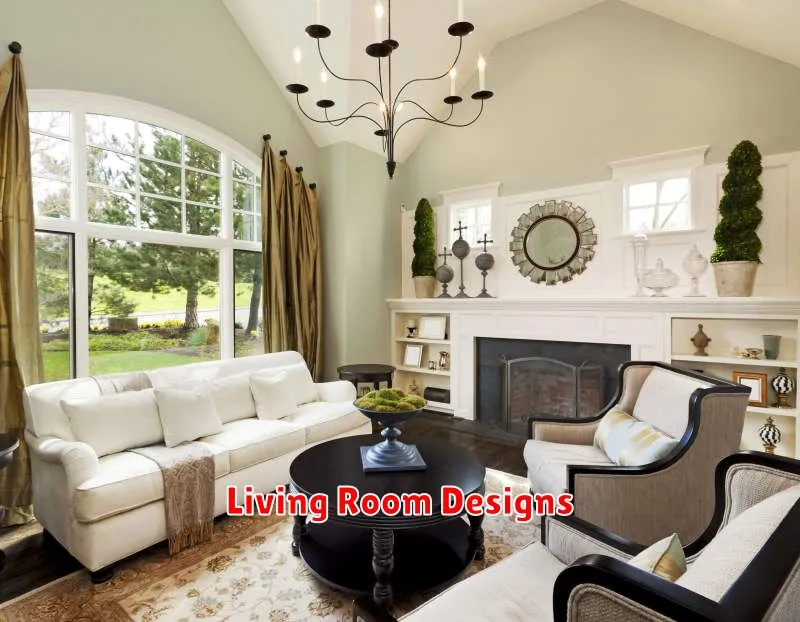Ready to revamp your living space and create a home you truly love? This article reveals the top 8 living space designs that will transform your house into a haven. We’ll explore stunning interior design ideas, from cozy and minimalist to chic and maximalist, perfect for any home decor style. Discover inspiring living room designs, learn how to maximize your space with clever furniture arrangement techniques, and unlock the secrets to creating a truly functional and stylish living area. Get ready to be amazed by these incredible transformations and find the perfect living space design to match your personality and lifestyle!
Bohemian Living Room
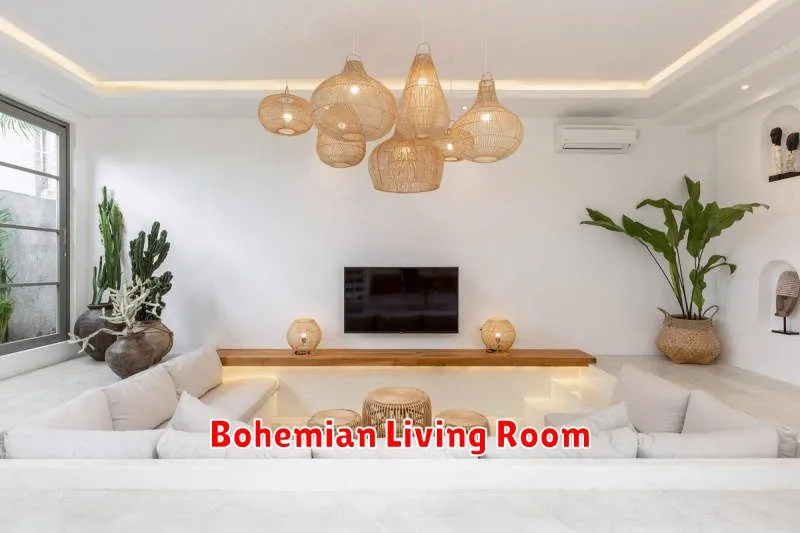
Embrace the free-spirited and eclectic vibe of a Bohemian living room. This style celebrates individuality and layers textures, colors, and patterns to create a space that’s both vibrant and inviting. Think globally-inspired textiles, handcrafted furniture, and a relaxed, unpretentious atmosphere.
Color palettes are typically rich and warm, often featuring earthy tones like terracotta, ochre, and burnt orange. These are balanced with jewel tones such as deep blues, emerald greens, and rich purples, creating a sense of depth and visual interest. Don’t be afraid to mix and match – a key element of the Bohemian aesthetic is its fearless embrace of diverse patterns and hues.
Textiles play a crucial role in establishing the Bohemian feel. Think layered rugs in varying textures and patterns, plush cushions scattered across sofas and armchairs, and woven throws draped over furniture. Incorporate natural materials like cotton, wool, silk, and jute for a truly authentic feel. Consider adding macrame wall hangings or tapestries to further enhance the textural richness.
Furniture should be comfortable and eclectic. Mix and match different styles and materials, incorporating vintage pieces alongside more modern designs. A low-slung sofa or a collection of mismatched armchairs will create a relaxed and inviting seating area. Add in a few ottomans or poufs for extra seating and a touch of bohemian flair.
Accessorizing is where you can truly let your personality shine. Display your favorite collections of pottery, sculptures, or ethnic artifacts. Include plenty of plants – both real and artificial – to bring life and vibrancy to the room. Candles and lanterns add warmth and create a cozy ambiance, particularly in the evenings.
Remember, a Bohemian living room is all about creating a space that reflects your unique style and personality. Don’t be afraid to experiment and personalize your space to create a truly unique and captivating environment. Let your creativity flow and enjoy the process of building your own personal bohemian haven!
Minimalist Scandinavian Design
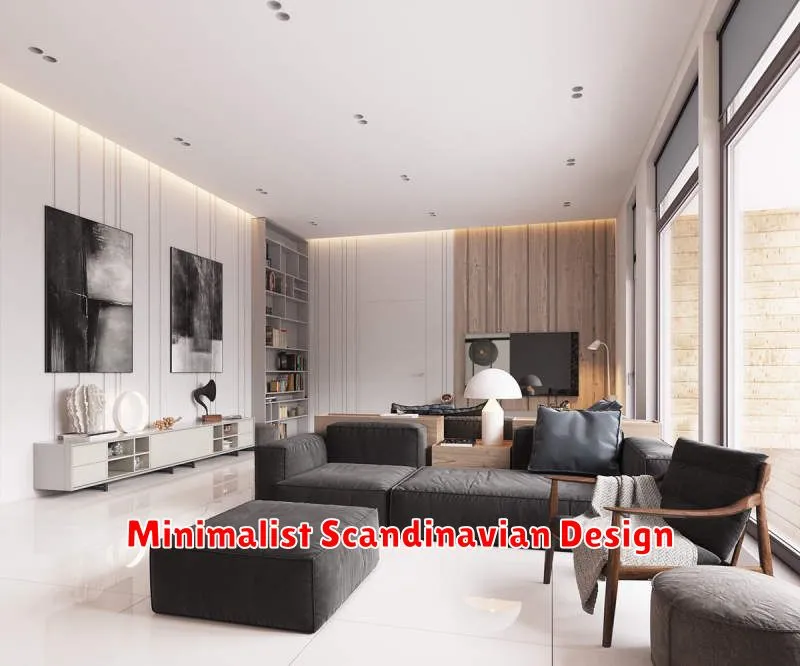
Scandinavian design, with its emphasis on minimalism and functionality, has taken the world by storm. Characterized by its clean lines, natural materials, and light color palettes, it’s a style that promotes a sense of calm and serenity within the home. But what exactly makes it so appealing, and how can you incorporate it into your own living space?
One of the key elements of minimalist Scandinavian design is its focus on simplicity. Clutter is kept to a minimum, with only essential items displayed. This isn’t about stark emptiness, however; it’s about carefully curating your possessions to create a space that feels both inviting and uncluttered. Think carefully about each piece you bring into your home, ensuring it serves a purpose and adds to the overall aesthetic.
Natural materials are another hallmark of this style. Think wood, wool, linen, and cotton. These materials bring warmth and texture to the space, contrasting beautifully with the clean lines of the furniture and décor. The use of light wood, particularly birch and pine, is particularly common, adding a touch of Scandinavian charm.
The color palette is typically light and airy, often featuring whites, creams, grays, and muted pastels. These colors help to maximize the feeling of space and light, making even smaller rooms feel larger and more inviting. Pops of color can be introduced through carefully selected accessories, such as cushions, throws, or artwork, but these should be used sparingly to avoid disrupting the overall sense of calm.
Functionality is paramount in Scandinavian design. Furniture is chosen for its practicality as well as its aesthetics. Multi-functional pieces, such as ottomans with storage or beds with built-in drawers, are particularly popular. The focus is on creating a space that is both beautiful and efficient, where everything has its place.
Finally, natural light plays a crucial role in Scandinavian design. Large windows are often a feature, maximizing the amount of natural light that enters the space. This not only brightens the room but also helps to create a sense of connection with the outdoors. Mirrors can also be used strategically to reflect light and enhance the feeling of spaciousness.
By incorporating these key elements – simplicity, natural materials, a light color palette, functionality, and natural light – you can create a truly stunning and serene space that embodies the best of minimalist Scandinavian design. It’s a style that transcends trends, offering a timeless and elegant aesthetic that will stand the test of time.
Rustic Farmhouse Living Space
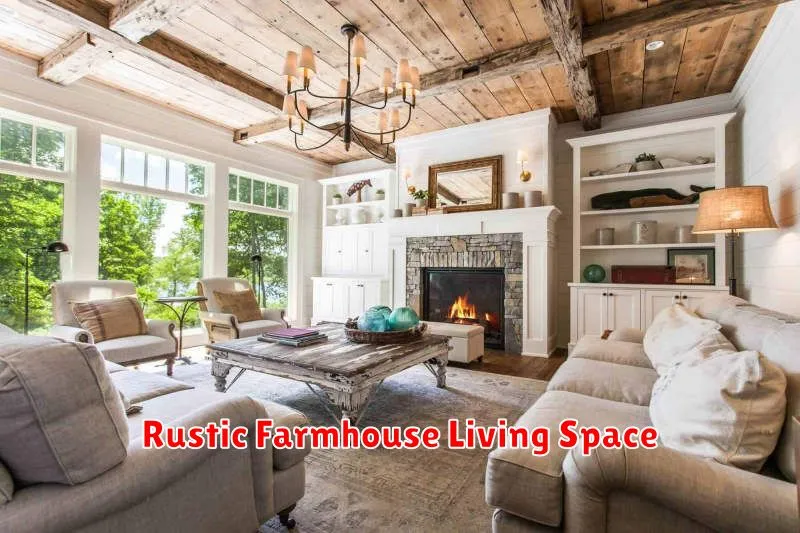
Creating a rustic farmhouse living space is all about embracing a blend of comfort, simplicity, and natural elements. It’s a style that feels both inviting and effortlessly chic, perfect for those who appreciate a touch of vintage charm mixed with modern practicality.
The key to achieving this look lies in carefully selected furnishings and décor. Think distressed wood furniture, perhaps a worn-out coffee table with a lived-in patina, complemented by a plush, oversized sofa in a neutral tone like beige or cream. Incorporate natural textures like linen, cotton, and wool through throws, cushions, and rugs. These elements add depth and warmth to the space.
Lighting plays a crucial role in setting the ambiance. Opt for a combination of soft, ambient lighting with perhaps a statement chandelier or rustic pendant lamps above the dining area. Consider adding some table lamps with warm-toned shades for a cozy and intimate atmosphere. Remember that soft lighting enhances the rustic feel significantly.
Don’t forget the details! Adding vintage or antique accents, such as a collection of old mason jars, a weathered wooden sign, or a galvanized metal bucket, can add character and authenticity. Fresh flowers or greenery in simple ceramic vases contribute to the overall feeling of warmth and life. These small touches elevate the aesthetic beyond a simple furniture arrangement.
Finally, color palettes for a rustic farmhouse space often revolve around neutrals with pops of color. Think soft whites, creams, grays, and beiges as your base, accented with subtle hues of blue, green, or terracotta. These create a visually balanced yet vibrant environment, and avoid overwhelming the space with excessive color.
By focusing on these key elements – natural materials, comfortable furnishings, warm lighting, and thoughtful details – you can create a rustic farmhouse living space that’s both stylish and inviting, a haven of comfort and charm that reflects your personal style.
Mid-Century Modern Style
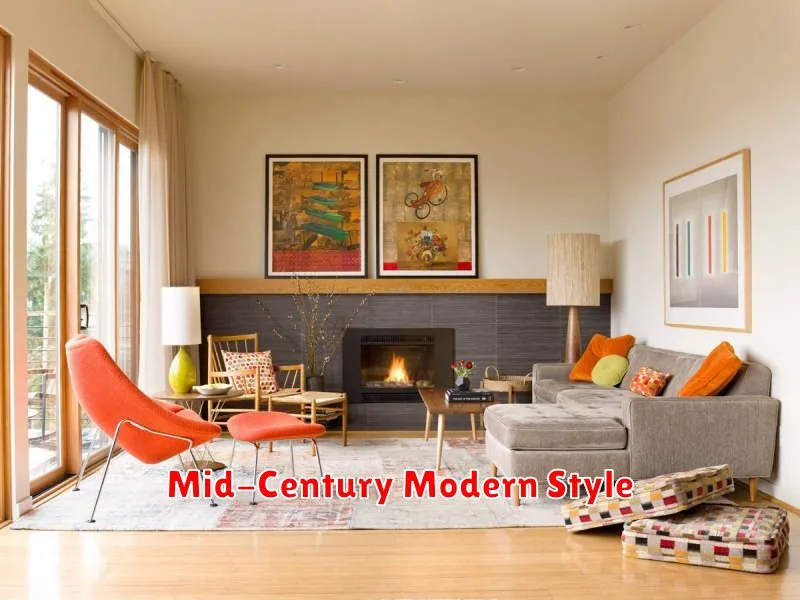
Mid-Century Modern, a design movement spanning roughly from the 1930s to the 1960s, continues to captivate homeowners and designers alike. Its timeless appeal stems from a unique blend of clean lines, organic forms, and a focus on functionality. This style effortlessly balances simplicity with sophistication, resulting in spaces that are both aesthetically pleasing and incredibly livable.
Key characteristics of Mid-Century Modern include the use of natural materials such as wood, leather, and wool. Think warm, richly toned woods like walnut and teak, often paired with sleek metal accents like chrome or brass. Furniture pieces are frequently characterized by tapered legs, organic curves, and a distinct lack of ornamentation. The emphasis is on the inherent beauty of the materials and the craftsmanship involved.
Color palettes in Mid-Century Modern designs are typically muted and earthy. Think shades of beige, mustard yellow, teal, and olive green. These colors are often combined with pops of bolder hues like burnt orange or deep turquoise for visual interest. The overall feeling is one of calm sophistication, a deliberate departure from the more ornate styles that preceded it.
Beyond furniture, the style extends to architecture and interior design. Open floor plans, large windows to maximize natural light, and a connection between indoor and outdoor spaces are all hallmarks of Mid-Century Modern homes. This emphasis on light and space contributes to a sense of airy spaciousness.
While Mid-Century Modern is rooted in the past, its versatility allows for adaptation to contemporary tastes. Modern interpretations often incorporate updated materials and technology while maintaining the core principles of the style. The result is a design aesthetic that feels both classic and current, guaranteeing its continued popularity for years to come. Whether you’re renovating your home or simply seeking inspiration for a fresh look, Mid-Century Modern offers a wealth of possibilities.
Luxury Industrial Loft
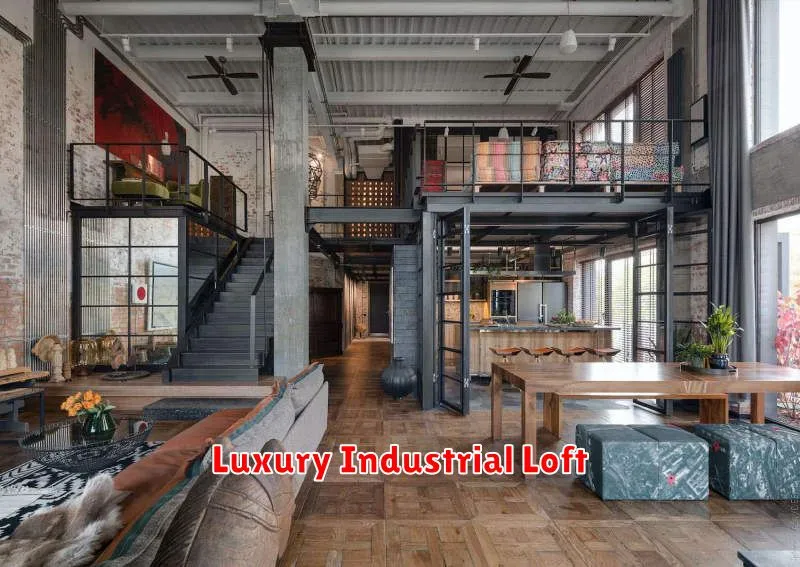
Step into a world of refined ruggedness with our stunning Luxury Industrial Loft. This unique space seamlessly blends the raw, authentic charm of industrial design with the sophisticated elegance of high-end luxury. Imagine exposed brick walls, soaring ceilings, and expansive windows, all carefully curated to create a truly unforgettable living experience.
The heart of the loft is undoubtedly the open-plan living area. Here, the industrial aesthetic is celebrated with features like polished concrete floors, exposed ductwork, and vintage-inspired lighting fixtures. Yet, these elements are balanced by luxurious touches – a plush, oversized sofa, a statement fireplace, and carefully selected artwork that adds depth and personality.
The kitchen is a chef’s dream, boasting sleek, stainless steel appliances, custom cabinetry, and a large island perfect for both preparing meals and casual gatherings. The use of dark wood and metallic accents further emphasizes the industrial theme, creating a space that is both functional and stylish.
Privacy is ensured by the separate master suite, a sanctuary of calm amidst the loft’s energetic vibe. This tranquil retreat features a spa-like bathroom with a soaking tub and a walk-in shower, providing the perfect escape after a long day. The bedroom itself is bathed in natural light, creating a serene space for relaxation and rejuvenation.
Beyond the primary living spaces, the loft offers ample opportunities for personalization. A dedicated home office provides a quiet workspace, while additional sleeping quarters or a guest suite can be easily incorporated. The possibilities are truly endless, allowing you to create a space that is uniquely yours.
This is more than just a living space; it’s a statement. It’s a testament to the beauty found in the unexpected juxtaposition of opposites, where industrial strength meets sophisticated comfort. Experience the allure of the Luxury Industrial Loft – a space that will inspire and captivate for years to come.
Contemporary Urban Living Room
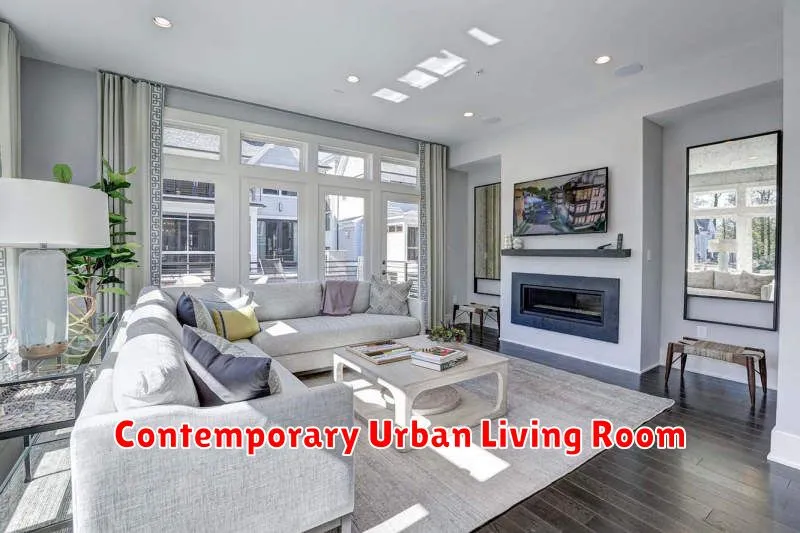
Designing a contemporary urban living room requires a careful balance of style and functionality. The space needs to feel both stylish and comfortable, reflecting the energy of city life while providing a tranquil retreat at the end of the day.
Color palettes are key. Think neutral bases like greys, whites, and beiges, accented with pops of bold color. Deep blues, emerald greens, or even vibrant yellows can add visual interest without overwhelming the space. Consider incorporating texture through materials like velvet, linen, and wool to add depth and warmth.
Furniture selection is crucial. Opt for clean lines and minimalist designs. A sectional sofa can maximize seating while maintaining a streamlined look. Consider incorporating multifunctional pieces, such as ottomans with storage or coffee tables that double as workspaces. Avoid clutter; less is often more in a contemporary setting.
Lighting plays a vital role in setting the mood. Layer different light sources – ambient, task, and accent – to create a versatile and inviting atmosphere. Think sleek pendants or floor lamps for ambient light, task lighting for reading, and accent lighting to highlight artwork or architectural features.
Finally, don’t forget the accessories. A few carefully chosen items can make all the difference. Consider adding a statement rug to anchor the space, a few well-placed throw pillows to add comfort and texture, and some interesting artwork to reflect your personal style. Keep it minimal and curated for a truly contemporary feel.
By incorporating these elements, you can create a contemporary urban living room that is both stylish and functional, reflecting the vibrancy of city life while providing a haven of peace and relaxation.
Open-Plan Living Space
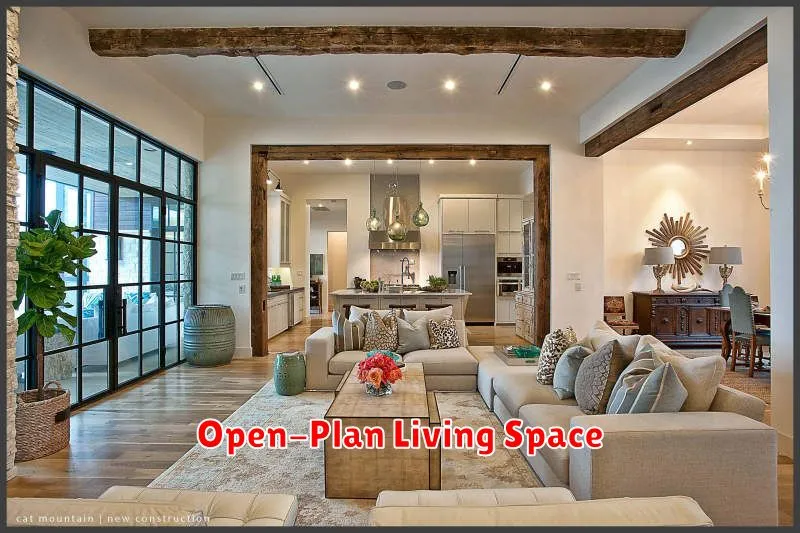
An open-plan living space is a design concept that combines multiple areas, such as the living room, dining room, and kitchen, into one large, uninterrupted area. This creates a sense of spaciousness and flow, making the home feel more open and inviting.
Benefits of open-plan living include increased natural light, improved family interaction, and a more modern aesthetic. The lack of walls allows light to penetrate deeper into the space, brightening even dimly lit corners. Families can more easily interact while undertaking different activities, and the unified space often lends itself to more creative and flexible furniture arrangements.
However, there are also challenges associated with open-plan design. Noise can be more easily transmitted throughout the space, making it less ideal for those who need quiet areas for work or relaxation. Maintaining tidiness can also be more demanding, as clutter in one area is immediately visible from others. Furthermore, defining distinct zones within an open-plan space requires careful planning and often necessitates the use of creative design techniques like rugs, lighting, and furniture placement to delineate different functional areas.
Designing an effective open-plan living space involves careful consideration of several factors. The layout needs to be well-thought-out to ensure a smooth flow and avoid cramped areas. The choice of materials and colors can greatly impact the overall atmosphere, while strategic lighting can enhance the space and create distinct zones. Storage solutions are crucial for managing clutter and maintaining a sense of order. Ultimately, a successful open-plan design is one that balances openness and functionality, creating a living space that is both stylish and practical.
In conclusion, open-plan living spaces offer a number of advantages but also present some unique challenges. By carefully considering these aspects during the design phase, homeowners can create a space that maximizes the benefits while mitigating the drawbacks, resulting in a beautiful and functional home environment.
Eco-Inspired Living Room
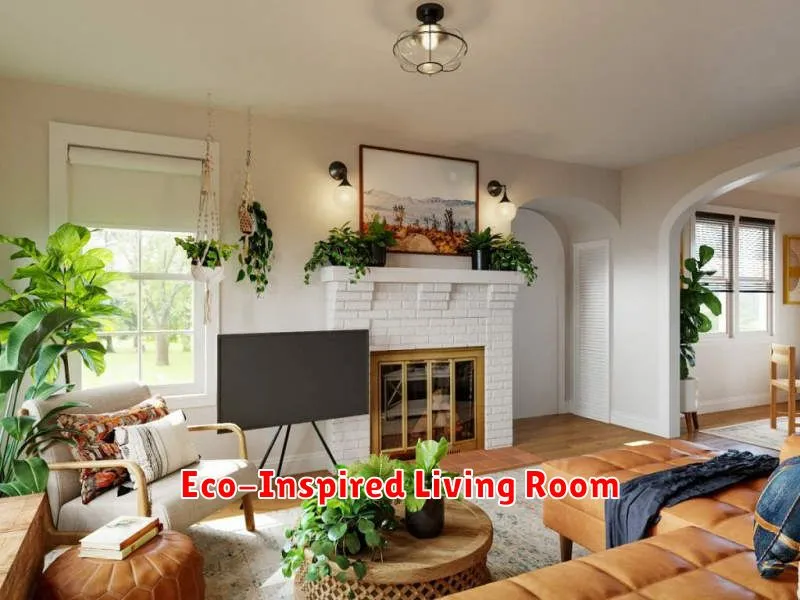
Creating an eco-inspired living room is more than just a design trend; it’s a commitment to sustainable living and a celebration of natural beauty. By making conscious choices about materials and decor, you can transform your space into a haven that’s both stylish and environmentally friendly.
Natural Materials are key to achieving this look. Think sustainable wood furniture, perhaps reclaimed or certified by organizations like the Forest Stewardship Council (FSC). Rattan, bamboo, and jute offer beautiful and durable options for furniture, rugs, and baskets, adding texture and warmth to the room. Consider incorporating organic cotton or linen fabrics for upholstery and throws.
Color palettes should reflect the natural world. Earthy tones like greens, browns, and creams create a calming and inviting atmosphere. Incorporate pops of color with natural dyes or sustainably sourced pigments. Think about the subtle greens of moss, the deep browns of rich soil, or the soft creams of sand and stone.
Lighting plays a crucial role in setting the mood. Opt for energy-efficient LED lighting and supplement with natural light whenever possible. Consider incorporating natural fiber shades or handmade lamps made from sustainable materials to add a touch of artisan craftsmanship.
Reduce, reuse, recycle should be your guiding principles when it comes to decor. Give old furniture a new lease of life with a coat of paint or new upholstery. Repurpose vintage items and incorporate upcycled pieces to add character and reduce your environmental impact. Support local artisans and makers who prioritize sustainability.
Finally, consider adding plants to purify the air and bring the outdoors in. Houseplants not only improve air quality but also add a touch of life and vibrancy to the space. Choose low-maintenance options that thrive in indoor environments.
By incorporating these elements, you can create a beautiful and eco-conscious living room that reflects your values and contributes to a more sustainable future. Remember, every small change makes a difference.

